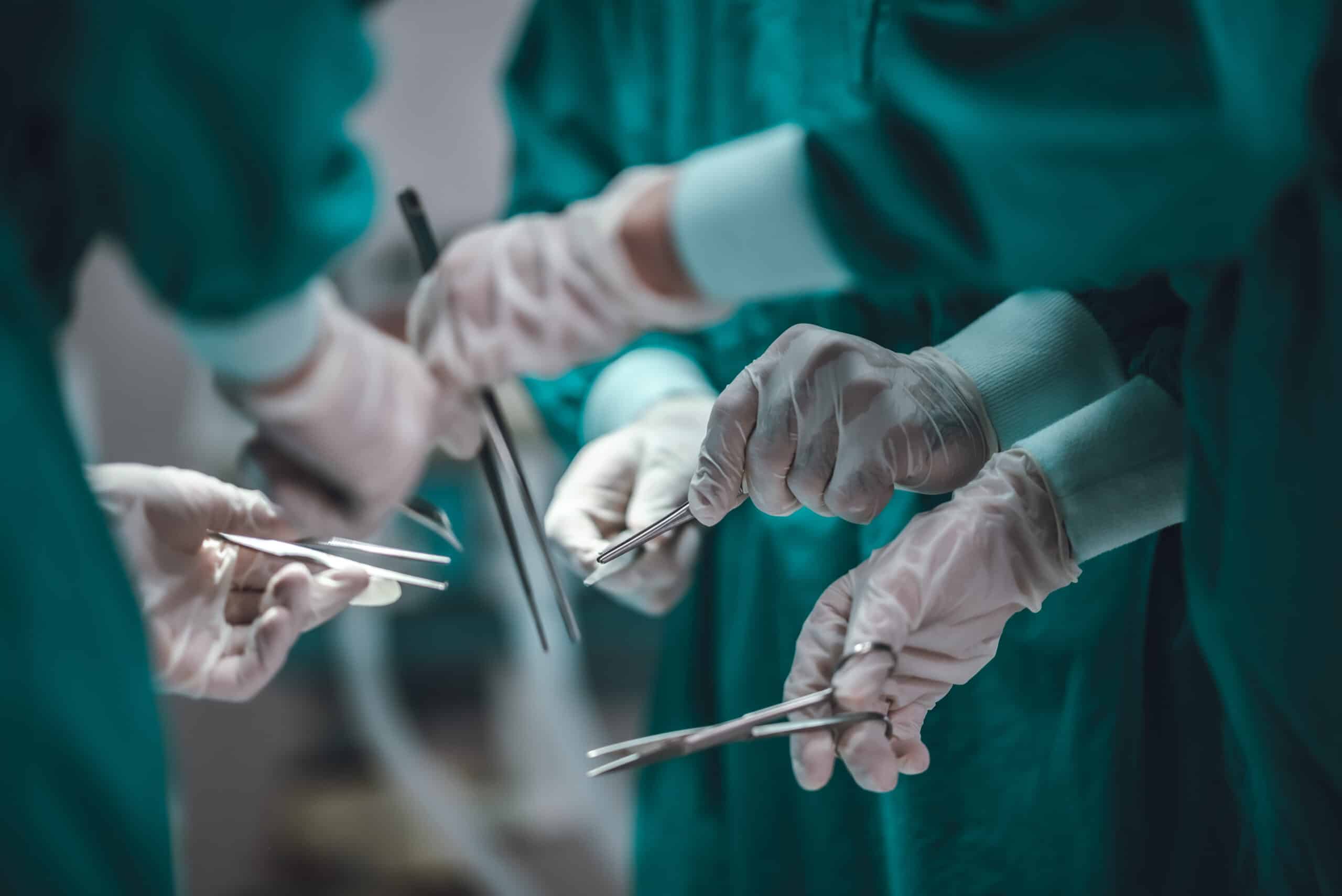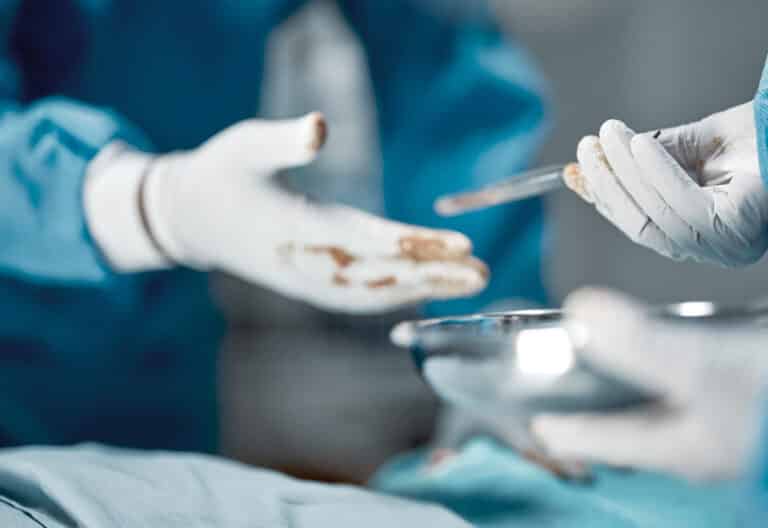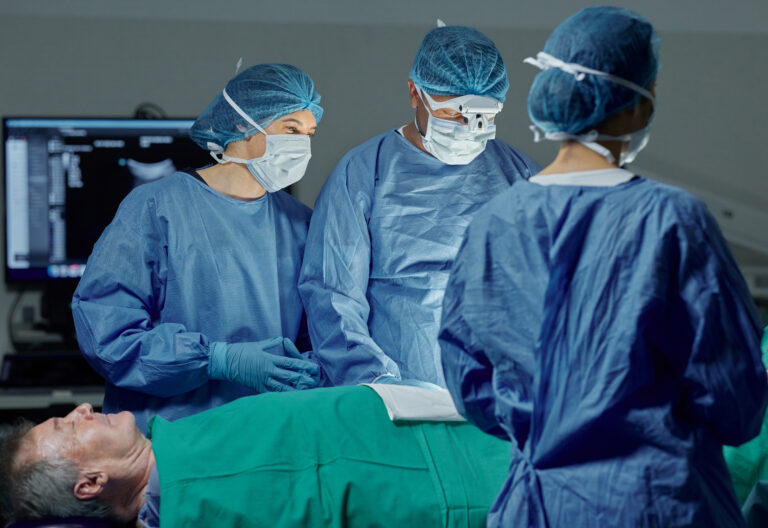Did you know that surgical Techs can tell about a surgical instrument by just a touch? Yes, you heard that right.
The mastery of surgical instruments is a fundamental aspect of a Surgical Technologist’s role, impacting every stage of the surgical process.
They are responsible for ensuring that the correct instruments are available and in optimal condition for each procedure.
So, if you want to become a surgical tech, you should start by familiarising with the instruments that are used before, during, and after a surgical procedure.
Now, to help you out, in this article, we’ll discuss the different types of surgical instruments, why surgical Techs should know about them, and much more.
Let’s get started.
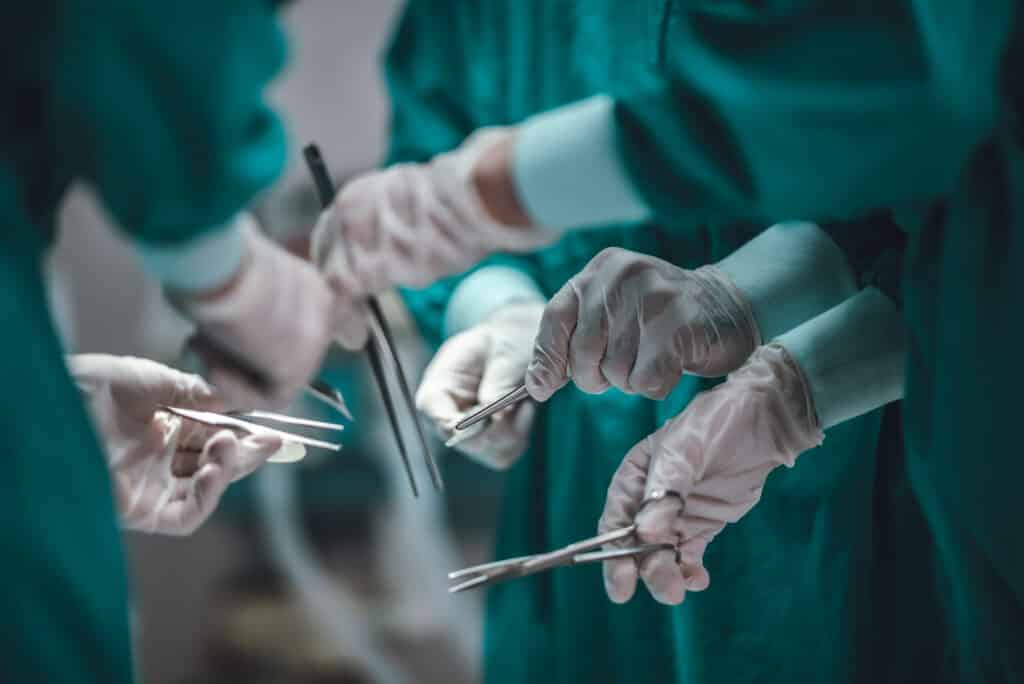
Instruments Used By Surgical Techs
In the realm of surgery, instruments are the lifeblood of the operating room, providing the necessary tools to perform intricate and life-saving procedures.
These instruments play a pivotal role in various stages of surgery, aiding in preparation, execution, and post-operative care.
Surgical Techs must have a deep understanding of these instruments to ensure that surgeries proceed smoothly and efficiently.
Their expertise in managing and utilizing these tools directly impacts the success of surgical outcomes and patient safety.
They are responsible for ensuring that the correct instruments are available and in optimal condition for each procedure.
They must be knowledgeable about the function and handling of a wide array of surgical tools to support surgeons effectively.
Read:
-> What Does a Surgical Tech Do?
This knowledge is crucial for several reasons:
Efficiency
Knowing the instruments allows Surgical Techs to anticipate the needs of the surgeon, reducing downtime and enhancing the flow of the operation.
Safety
Proper handling and management of instruments minimize the risk of infection and complications during and after surgery.
Precision
Understanding the specific use of each instrument ensures that the right tool is used at the right time, contributing to the accuracy and success of the surgical procedure.
Three Types of Instruments Used By Surgical Techs
The mastery of surgical instruments is a fundamental aspect of a Surgical Tech’s role, impacting every stage of the surgical process.
By understanding and proficiently handling these instruments, Surgical Techs play an indispensable role in the success of surgical procedures and the overall well-being of patients.
Pre-Operative Instruments
The term “pre-operative” refers to the period and processes before the actual surgical procedure. Instruments used in this phase help in initial preparations such as sterilizing the surgical area, organizing surgical supplies, and ensuring that all equipment is ready for use.
Operative Instruments
The term “operative” pertains to the actual operation or surgery. Instruments used in this phase are critical for performing the surgical tasks and manipulations required to achieve the desired medical outcome.
Post-Operative Instruments
The term “post-operative” refers to the period following the surgical procedure. Instruments used in this phase support the final steps of surgery and contribute to the patient’s recovery and healing process.
Now, let’s discuss about each type of instrument in detail –
Read:
-> Is Surgical Tech School Hard?
Pre-Operative Instruments
In any surgical procedure, the preparation phase is critical to ensure a successful outcome. Pre-operative instruments are used to prepare both the patient and the operating room for surgery.
These tools are essential in creating a sterile environment and ensuring that all necessary preparations are made before the actual operation begins.
These instruments are meticulously sterilized and arranged to facilitate smooth operation and efficiency during surgery.
Here are the key pre-operative instruments:
Scalpel
A scalpel is a small, sharp knife used for making precise incisions in the patient’s skin.
Surgical Techs ensure that the scalpel is sterile and readily available for the surgeon at the beginning of the operation. It is the primary tool for initiating surgical procedures.
Scissors
Surgical scissors come in various shapes and sizes, each designed for specific tasks.
Scissors are essential for cutting tissues, sutures, and materials during surgery. Surgical Techs prepare different types of scissors, such as Metzenbaum scissors for delicate tissues and Mayo scissors for heavier tissue, ensuring they are sharp and sterile.
Forceps
Forceps are tweezer-like instruments used to grasp and hold tissues, vessels, or other objects.
Surgical Techs provide various types of forceps, such as tissue forceps and hemostatic forceps, to the surgical team. These instruments are crucial for manipulating and securing tissues during the procedure.
Needle Holder
Needle holders are designed to hold needles firmly while suturing tissues together.
Surgical Techs ensure needle holders are available for the surgeon to use during suturing. They must be properly aligned and sterilized to facilitate efficient suturing.
Operative Instruments
Operative instruments are used during the surgical procedure itself. These tools are directly involved in the execution of the surgery, assisting in tasks such as making incisions, retracting tissues, and controlling bleeding.
Here are the most common instruments:
Surgical Drapes
Surgical drapes are sterile coverings used to create a sterile field around the surgical site. They are essential for preventing contamination by isolating the surgical area from surrounding non-sterile regions.
Surgical Techs carefully place these drapes to maintain a clean environment and protect the patient from infection.
Surgical Suction Devices
Surgical suction devices are tools designed to remove blood, fluids, and debris from the surgical area. These devices are crucial for maintaining clear visibility for the surgeon, ensuring that the operative field remains unobstructed.
Surgical Techs are responsible for setting up, adjusting, and maintaining these devices throughout the procedure.
Retractors
Retractors are instruments used to hold back tissues and organs, providing exposure and access to the surgical field. They come in various shapes and sizes to accommodate different types of surgeries.
Surgical Techs select, provide, and position retractors to give the surgeon the best possible view and access to the area being operated on.
Electrocautery Devices
Electrocautery devices use electrical current to cut tissue and coagulate blood vessels, helping to control bleeding during surgery. These devices are essential for both cutting through tissue and minimizing blood loss.
Surgical Techs prepare, handle, and assist with the use of electrocautery devices to ensure precise cutting and effective hemostasis.
Also Read:
-> How To Become A Surgical Tech?
-> Pros And Cons Of Being A Surgical Tech
-> How To Become A Certified Surgical Tech?
-> How Long Does It Take To Become A Surgical Tech?
Post-Operative Instruments
Post-operative care is a critical phase of the surgical process, focusing on wound care and patient recovery. Surgical Techs play an essential role in managing and preparing post-operative instruments, ensuring that they are ready for use and properly maintained.
Post-operative instruments are utilized after the surgery to aid in wound care, promote healing, and ensure proper recovery of the patient. These tools are essential for closing incisions, managing bleeding, and providing post-surgical care.
Here are the most common post-operative instruments:
Surgical Dressings
Surgical dressings are materials applied to incisions and wounds post-surgery to protect and promote healing. These dressings help absorb exudate and maintain a sterile environment, essential for preventing infection.
Surgical Techs are responsible for preparing and applying these dressings to ensure the surgical sites are securely covered and conducive to recovery.
Surgical Staples and Sutures
Surgical staples and sutures are utilized to close incisions and wounds effectively. These tools come in various types to match different tissues and surgical needs.
Surgical Techs ensure the availability and sterility of the appropriate staples and sutures, assisting the surgical team in closing incisions to facilitate proper healing and minimize infection risk.
Hemostats
Hemostats are essential clamping instruments used to control bleeding by securing blood vessels or tissues. During and after surgery, these tools are crucial for managing hemorrhaging and stabilizing the patient.
Surgical Techs skillfully use hemostats to maintain a clear and safe surgical field, ensuring effective bleeding control.
Sterilization Equipment
Sterilization equipment is used to clean and sterilize surgical instruments for future use.
Surgical Techs operate sterilization equipment, such as autoclaves, to ensure that all surgical instruments are properly cleaned and sterilized. This is vital for preventing infections and maintaining a sterile environment for future surgeries.
Ultimately, the management of post-operative instruments is a critical aspect of ensuring successful patient recovery and wound care.
Their meticulous attention to detail and adherence to sterile techniques help promote healing, prevent infections, and ensure that patients recover smoothly.
Effective post-operative care, supported by the proper use of these instruments, is essential for optimal surgical outcomes and patient well-being.
You May Also Like:
-> Surgical Tech Programs Online
-> Surgical Tech Certificate Program
Additional Instruments Frequently Utilized By Surgical Techs
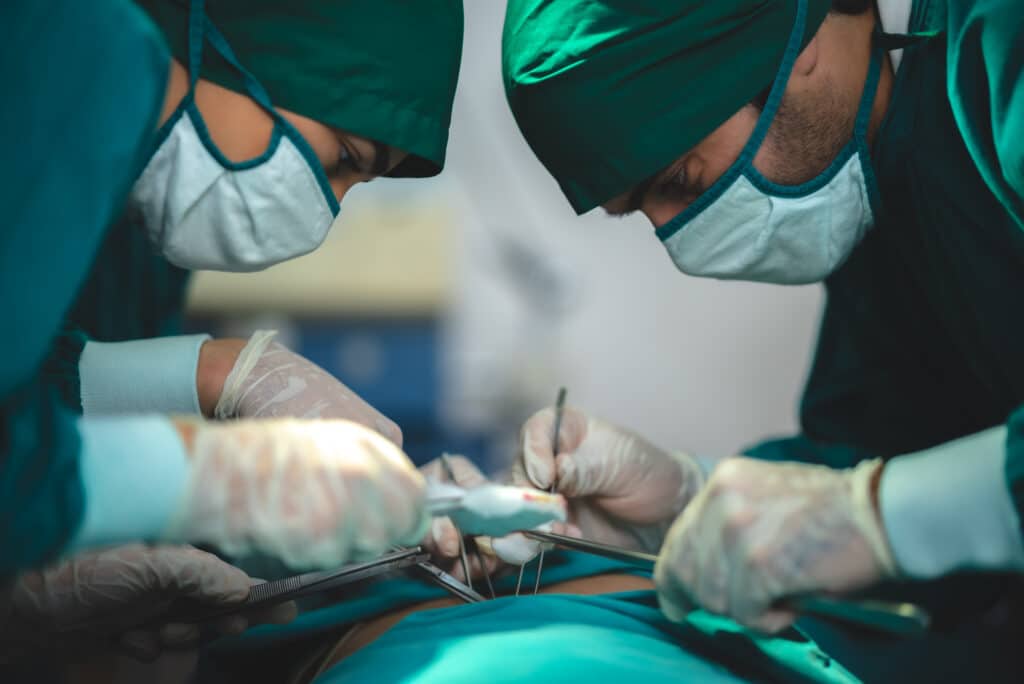
Surgical Techs play a crucial role in ensuring that surgical procedures run smoothly by preparing and managing a variety of specialized instruments.
Each instrument serves a specific function in assisting surgeons during operations. Understanding these instruments and their applications is essential for effective surgical support.
This section provides detailed descriptions and uses of additional instruments frequently utilized by Surgical Techs.
1. Kocher Forceps
Kocher Forceps, also known as Kocher’s clamps, are heavy-duty forceps with serrated jaws and a locking mechanism near the handle.
These forceps are used to grasp tough tissues or structures such as fascia and muscles during surgery. They provide a secure grip and are crucial for holding tissues in place without slipping.
2. Yankauer Suction Tip
The Yankauer Suction Tip is a rigid, non-ventilated suction device with a bulbous tip and multiple holes on the sides.
Surgical Techs use the Yankauer Suction Tip to remove blood, fluids, and debris from the surgical site, ensuring clear visibility for the surgeon throughout the procedure.
3. Allis Clamp
Allis Clamps have a ratcheted, locking mechanism with sharp, interlocking teeth along the jaws.
These clamps are designed to grasp and hold heavy tissue or structures during surgery. They provide a firm grip, allowing surgeons to manipulate tissues without causing damage.
4. Russian Tissue Forceps
Russian Tissue Forceps have a heavy, serrated tip with longitudinal rows of fine teeth.
Surgical Techs use these forceps for gripping and manipulating tough, heavy tissues during procedures. The serrated tips provide a secure hold, making them ideal for handling dense tissues.
5. Adson Forceps
Adson Forceps are fine, delicate forceps with a narrow, serrated tip and a wide, flat thumb grasp area.
These forceps are used for holding delicate tissues such as skin or delicate structures during surgery. They provide precise control and a secure grip without causing tissue trauma.
Also Read:
-> Surgical Scrub Tech Certification
-> Can You Be A Surgical Tech Without Certification?
6. Suture
Sutures, also known as stitches, are threads or strands used to close wounds, incisions, or surgical openings.
Surgical Techs provide various types of sutures, including absorbable and non-absorbable materials, to the surgical team. They assist in suturing tissues together, promoting wound healing and closure.
7. Debakey Forceps
Debakey Forceps have a delicate, atraumatic tip with fine serrations along the jaws.
These forceps are used for handling delicate tissues such as blood vessels or organs during surgery. They provide a gentle grip and are designed to minimize tissue trauma or damage.
8. Senn Retractor
The Senn Retractor is a handheld, dual-ended instrument equipped with three or four prongs on each side.
Surgical Techs use the Senn Retractor to retract and hold back small or superficial tissues during procedures. It provides visibility and access to the surgical site without obstructing the surgeon’s view.
9. Curette
A Curette is a spoon-like tool with either a sharp or blunt edge, used for scraping or extracting tissue from body cavities or bones.
Surgical Techs use curettes to remove debris, diseased tissue, or bone fragments during surgical procedures. They are essential for precise tissue removal without causing unnecessary damage.
10. Metzenbaum Scissors
Metzenbaum Scissors are slender, precise scissors with gently curved blades and fine tips.
These scissors are used for dissecting and cutting delicate tissues such as fat or muscle during surgery. They provide precise cutting and are essential for fine surgical procedures.
11. Tenotomy Scissors
Tenotomy Scissors have short, blunt blades with sharp, pointed tips.
Surgical Techs use Tenotomy Scissors for cutting tendons or muscles during surgical procedures. They are designed to make precise cuts and are commonly used in orthopedic surgeries.
12. Gelpi Retractor
The Gelpi Retractor is a self-retaining, lightweight retractor with sharp, pointed prongs.
Surgical Techs position the Gelpi Retractor to hold and retract deeper tissues during surgery, providing clear access and visibility to the surgical site without manual assistance.
13. Richardson Retractor
Richardson Retractors are handheld, double-ended retractors with flat, blunt blades or prongs.
These retractors are used to hold back deeper tissues or organs during procedures, allowing the surgeon to work in deeper cavities or spaces.
14. Deaver Retractor
Deaver Retractors features a broad, flat blade with an angled or curved tip.
Surgical Techs use Deaver Retractors to retract large, deep tissues or organs during surgery. They provide broad exposure and maintain clear visibility for the surgeon.
15. Poole Suction
The Poole Suction Tip is a hollow, flexible suction device with multiple holes on the tip and sides.
Surgical Techs use the Poole Suction Tip to remove large volumes of blood, fluids, or debris from the surgical field. It helps maintain a clear operative field and prevents fluid accumulation.
16. Balfour Retractor
The Balfour Retractor is a self-retaining retractor with curved blades and an adjustable mechanism.
This retractor is used in abdominal surgeries to hold back the abdominal wall, providing exposure and access to abdominal organs during procedures.
17. Tonsil Clamp
Tonsil Clamps, also known as tonsil forceps, have a long, slender design with curved jaws and a locking mechanism.
These clamps are used to grasp and hold tonsils or other tissues during tonsillectomy or similar procedures. They provide a secure grip and facilitate precise tissue manipulation.
Read More:
-> Surgical Tech Job Description
Conclusion
We hope this article gives you a clear picture of the surgical instruments. Each of these instruments plays a vital role in surgical procedures, allowing Surgical Techs to assist surgeons effectively and ensure optimal patient outcomes.
Surgical tech’s knowledge and proficiency in preparing, handling, and maintaining these instruments contribute to the success of surgical operations.
Lastly, by understanding the specific functions and uses of each instrument, Surgical Techs can provide essential support in the operating room, contributing to the overall efficiency and safety of surgical procedures.
Related:
-> CVOR Tech
-> Scrub Nurse Vs Surgical Tech
-> 6-Week Surgical Tech Program
-> Surgical Tech Vs Surgical Assistant
